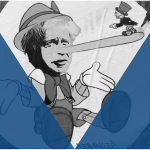
Dr Sylvia Shaw
Senior Lecturer in English Language and Linguistics at the University of Westminster. She has published ‘Gender, Power and Political Speech’, an analysis of the TV debates of the 2015 General Election (with Professor Deborah Cameron). Her monograph ‘Women, Language and Politics’ will be published in 2020
Email: S.Shaw@westminster.ac.uk

Section 8: Personality politics and Pop Culture
- Tune in, turn away, drop out: emotionality and the decision not to stand
- Order! Order! The Speaker, celebrity politics and ritual performance
- Last fan standing: Jeremy Corbyn supporters in the 2019 General Election
- What is Boris Johnson?
- Creating Boris: Nigel Farage and the 2019 election
- Boris the clown: the effective performance of incompetence
- Political humour and the problem of taking Boris seriously
- Joking: uses and abuses of humour in the Election campaign
- The problem with satirising the election
- Sounding Off: music and musicians’ interventions in the 2019 election campaign
- Stormzy, status, and the serious business of social media spats
The two head-to-head televised debates between Jeremy Corbyn and Boris Johnson in GE2019 (the first on ITV on 19th of November and the second on BBC on 6th December) offer an opportunity to examine the linguistic strategies and tactics each leader deployed to convey their message. The genre of the televised debate is one in which politicians must perform with strength and authenticity in order to be perceived as the winner. While more sophisticated augmentative models of consensus and reasoned debate are no doubt available, the televised debate continues to be conducted in competitive terms.
Gains can be made in televised debates by simply occupying the floor more than an opponent, and this relies on interactional power. First, a politician needs to speak for longer than an opponent and Johnson achieved this, speaking for approximately eight minutes more than Corbyn across both debates (three minutes more in the ITV debate and five minutes more in the BBC debate). This gain is significant as the length of speaking turns is strictly controlled by the moderators (Julie Etchingham in the first debate and Nick Robinson in the second). Johnson gained time by resisting the moderators and breaking the timing rules. This can be seen right from the first one-minute turn of the first debate where Corbyn speaks first for just under 60 seconds, and Johnson speaks for 70 seconds. Johnson resists four appeals by the moderator to stop speaking and gains ten extra seconds. This pattern is repeated throughout the debates, with Johnson ignoring and resisting the moderators’ enforcement of the timing rules and accruing time for himself.
Speakers can also gain the floor by violating the opponent’s speaking turn and both Corbyn and Johnson interrupt each other. However, Johnson interrupts Corbyn much more, and more successfully while Corbyn interrupts rarely and he allows Johnson to continue speaking afterwards. Johnson’s interruptions are not only much more frequent but also more intrusive and consistently wrest the speaking turn away from Corbyn. Johnson also dominates both debates throughout by taking the moderator’s role and directing the proceedings himself by asking Corbyn questions, particularly about Corbyn’s stance on Brexit. This tactic has many advantages as it allows Johnson to achieve the interactional upper hand by taking charge and pointing to the opponent’s weaknesses, but it also serves as an evasion. In both debates Johnson responds to critical questions about his own policies by immediately directing critical and derisive questions towards Corbyn.
Apart from interaction and the floor, televised debates are also characterised by adversarial language and personal attacks. Here Johnson seems to have a consistent ad hominem approach to Corbyn by portraying his leadership style as “dither and delay”, his ideas as “crackpot” and his policies as “Bermuda triangle type stuff” saying “it’ll be little green men next”. Johnson also uses single-word interjections like “nonsense” with accompanying theatrical shrugging gestures and head-shaking to undermine Corbyn’s points. In contrast, Corbyn does not use personal attacks at all but only attacks Johnson on his political record: on promises he made during the Brexit referendum campaign and on his plans for possible trade deals involving the NHS.
Corbyn’s consensual style in these debates and also in other adversarial speech events such as Prime Minister’s Question Time (PMQs) with Theresa May is highly unusual. He not only contradicts the accepted confines of the genre, but also defies gendered expectations as the competitive displays are stereotypically viewed as masculine. Conversely, Johnson, like Donald Trump in debates with Hilary Clinton in the 2016 US election, performs an overtly hyper-masculine version of adversarial interactional dominance. In practice, both men and women political leaders draw on a range of adversarial and consensual styles but in this case neither Johnson’s or Corbyn’s two extremes seem to be the most successful approach to adversarial speech events. Alternatively, these debates can be performed with warmth and humour, as shown by Nicola Sturgeon in the General Election debates of 2015, who used interruption, adversarial quips and wisecracks to great effect while avoiding some of the negative aggression of direct personal attacks.
Johnson’s interactional dominance of the head-to-head debates of GE2019 gave him more of the interactional floor than Corbyn, and his personal attacks showed Corbyn in a negative light. Although Corbyn arguably gave better answers to some of the ‘quick-fire’ questions, he was framed as the weaker participant by Johnson’s adversarial stance. This shows how carefully politicians must manage the combination of their own personal approach with the demands of the speech event genre. Whether in PMQs or televised debates the gains and losses of adversarial speech seem to be preserved in the proceedings and formats of the events. It is therefore possibly too risky for a leader to reject adversarial norms without either changing those formats or developing more sophisticated strategies to deflect and soften their negative effects.
